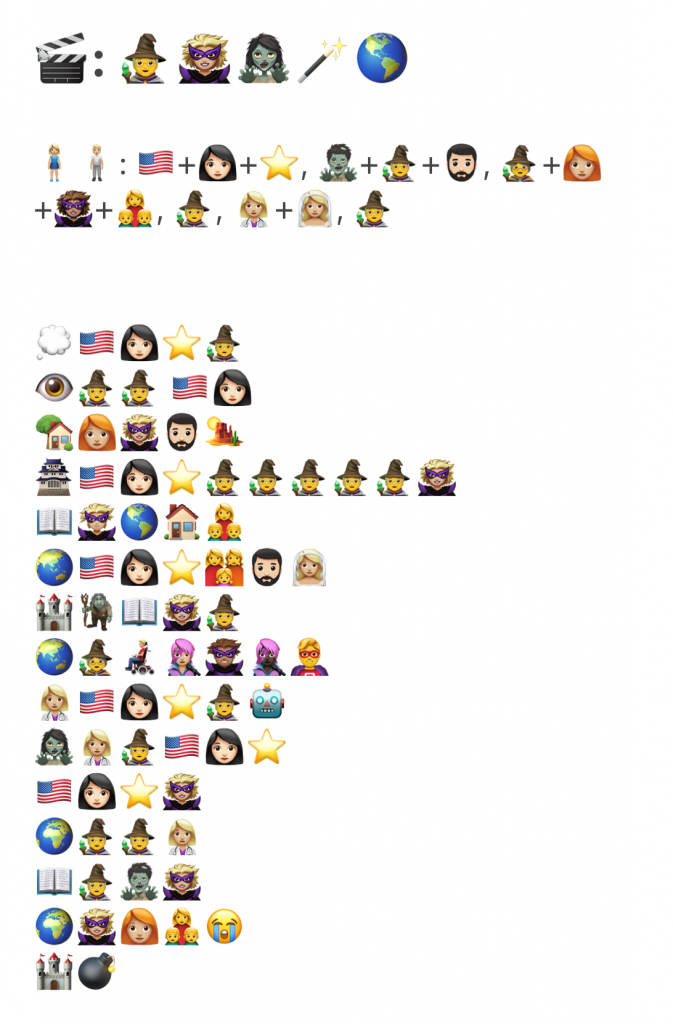
I originally started creating my emojis on https://emojikeyboard.io but the selection was limited so I opted with using the emoji feature available on my iPhone instead as they have a much larger selection of emojis to choose from. I found this task to be much more difficult than I anticipated. Despite using a different application to create my emoji story, I was still limited to the number and type of emojis I could choose from to describe the movie. This was perhaps the movie that I was describing was complex as the characters in the story could appear in different forms.
Did you rely more on syllables, words, ideas or a combination of all of them? Did you choose the work based on how easy would it be to visualize? Did you start with the title? Why? Why not?
When creating my emoji story I relied more on ideas than syllables or words. I first created the title, then listed out the characters, and then identified some of the main ideas and events that occurred in the movie. My initial thought was to start with the title as most people would at least know the name even if they have not seen the film or know the plot. Once I listed the movie I started to explain the plot but I encountered a challenge where I had trouble describing the characters. As previously mentioned the characters in the movie appeared in various forms, so I decided to list out all the characters and included a symbol plus (+) sign to show that this specific character could also appear in a different form in the movie. Once the characters were established I tend to identify the major events that occurred in the plot to include in my emoji story. During this process there were some portions of the movie that I had to take out or adjust slightly as I realized there was not an emoji that represented the specific idea I had in mind.
Reflecting on this assignment and comparing with the previous ones (specifically the manual script and Twine task), how we effectively convey a story requires a bit of both hypertext and graphics. That being said, there needs to be a balanced relationship with how much text and graphics appear in a specific amount space. Too much graphics may result in an unstable relationship yet readers are limited to a set amount of text information given to them at any certain time (Bolter, 2001). Looking back at my emoji story, if I were to show it to a friend I would be doubtful they would understand the story without any text. Multimodality is also important to consider in terms of representation culturally and socially (Kress, 2005). Further, the combination of both not only provides a visual appeal, but it also accessibility. Following Equity, Diversity, Inclusion, Decolonization, and Anti-Racism (EDIDA) frameworks, accessibility features such as captions, text-to-speech, and colour blind options provide a combination of text and visuals in order to support usability in technological tools.
References:
Bolter, J. D. (2001). Writing space: Computers, hypertext, and the remediation of print (2nd ed.). Mahwah, N.J: Lawrence Erlbaum Associates. doi:10.4324/9781410600110
Kress, G. (2005). Gains and losses: New forms of texts, knowledge, and learning. Computers And Composition, 22(1), 5-22. doi: 10.1016/j.compcom.2004.12.004

Hi Emily,
Thank you for sharing your emoji story. I appreciate the fact that you used the plus sign to show how the characters have different forms. However, I still cannot figure out which movie this is.
I found my process of creating the emoji story similar to yours. I also started with computer but switched to using my phone very quickly since more emojis are available on the handheld devices. There are more choices, such as skin colour and actions, on the handheld devices compared to computers. It makes me wonder this is a cautions decision made by the developer as a result of emoji being dominantly used for texting/posting on smart phones .
I, too, felt constrained by the limited number of pictures available through pre-made emojis. It felt very difficult to convey my ideas thoroughly. Your statement of balancing the amount of text and graphic is very intriguing. In the example of the emoji story, it is difficult to understand without the support of written words. However, in my opinion, the arrangement of text and graphics is a decision cautiously made through considerations of the purpose and audience of the representation. Sometimes the text is needed for detailed explanation, other times graphic may spark more emotional responses. Therefore, the choice is left to the author/maker to decide what works the best to convey the meaning he/she intends.
Hi Emily,
Thanks for your thoughtful post. I gave it my best, but couldn’t determine which movie you chose for your emoji story, but to be honest, I couldn’t really figure out anyone’s! I think this task really highlights how images can be complimentary to telling a story, but really aren’t sufficient in and of themselves. I agree with your point that there needs to be a balanced relationship with how much text and graphics appear in a space. It can also be difficult to read just a giant wall of text and pull the intended meaning from it. I do think that using images such as emojis can be useful in certain contexts, like conveying general ideas or symbolism.
Thanks again for your post, looking forward to reading more in the future!
Jordon